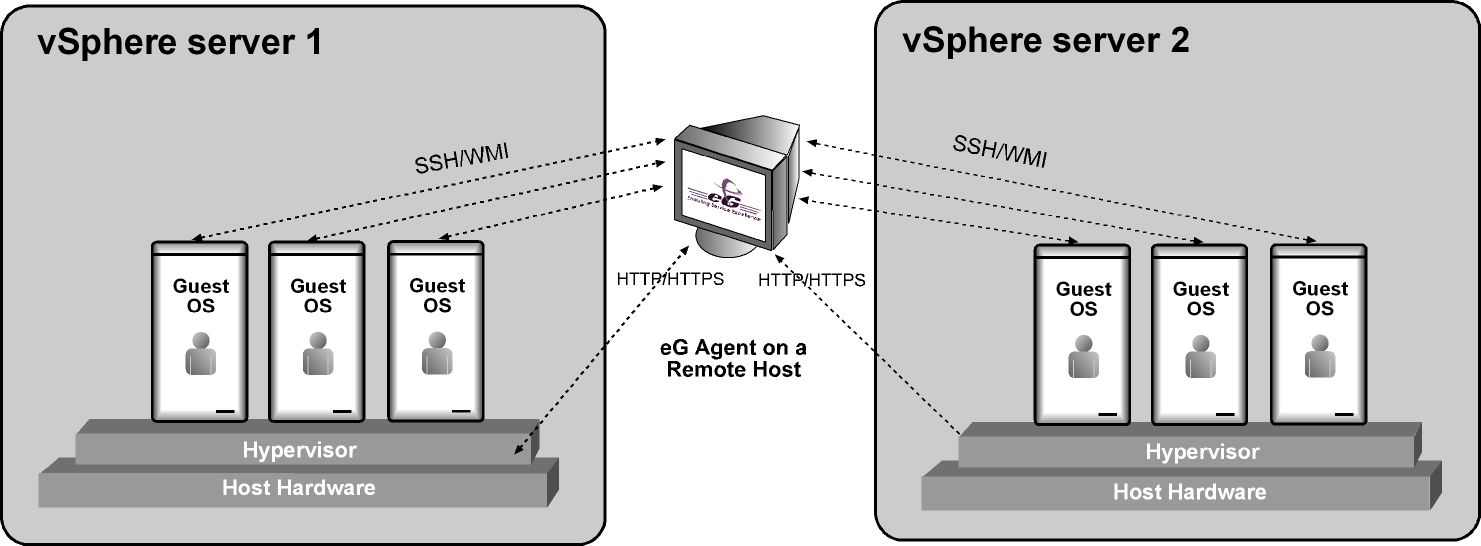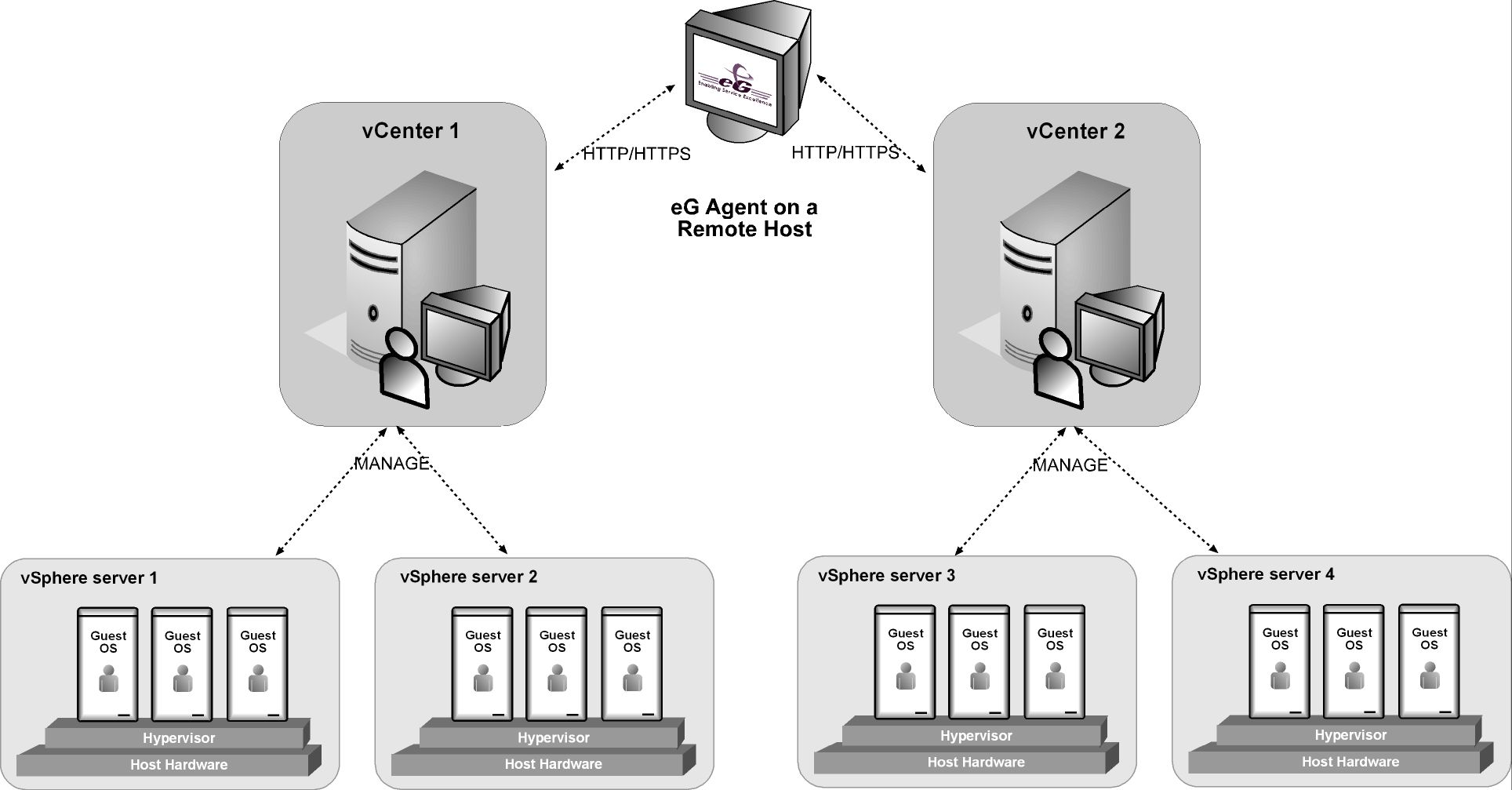How does eG Enterprise Monitor VMware Environments?
To monitor virtual infrastructures, eG Enterprise uses a patented In-N-Out monitoring approach that is designed to address the requirements outlined in Virtualization Deployment Models
In addition, the eG agent also connects to each guest VM that is currently powered on and determines the guest OS version, the name(s) of the users who are logged on (in the virtual desktop scenario), and the resource usage of the guest and the applications running inside the guest (as seen from within the guest operating system). This represents the view from within the guest operating system - i.e., the “inside” view.
With the In-N-Out monitoring approach, eG Enterprise allows administrators of VMware environments to answer several key questions. Some of these include:
- How many guest VMs are running on each VMware server, what is the IP address of each of guests, what operating system is each guest running, and when was the guest powered on?
- Which user is logged in to the guest VM, and when did he/she login?
- How much memory is allocated to each guest and does each guest VM have sufficient free memory?
- Does the ESX server have sufficient memory available to support the guest VMs that it is hosting?
- What is the CPU utilization of the ESX server and which of the guest VMs is taking up excessive CPU?
- Which application(s) running on each of the guest VMs is taking CPU, memory, and disk resources?
- Is there sufficient disk space in each of the disk partitions of the guest operating system?
- Which of the guests is seeing the highest and lowest network traffic?
- Is there excessive queuing for disk access on any of the guest VMs?
- What are peak usage times of the virtual desktops?
- Who are the most resource intensive users of a virtual desktop environment?
The eG agent that collects the ‘inside’ and ‘outside’ views of performance can be deployed on a remote system running a Windows/Linux/Solaris operating system. In other words, eG Enterprise supports only agentless monitoring of vSphere/ESX servers.
The agentless approach to monitoring vSphere/ESX servers involves the following:
- Deploying the eG agent on a remote system running Microsoft Windows or Linux or Solaris;
- Configuring the remote eG agent to communicate with the Web Services interface of the ESX server using HTTP/HTTPS;
- Deploying a light-weight eG VM Agent on each VM to pull 'inside view' metrics, and configuring the remote agent to communicate with the eG VM Agent for metrics collection. Refer to Configuring the Remote Agent to Obtain the Inside View of VMs for more details on the eG VM Agent.

Figure 1 : Agentless monitoring of vSphere/ESX servers
ESX 3.0, 3.5, ESXi, and vSphere servers can all be monitored using this approach.
The key advantages of agentless monitoring for ESX servers are:
- There is no need to install an eG agent on the ESX server or on any of the guests; related processing overheads, though minimal, can thus be saved.
- A single remote agent can monitor multiple ESX servers in the infrastructure.
Alternatively, instead of configuring the remote agent to communicate with each ESX server for guest discovery and data collection, you can simply configure the remote agent to talk to one/more vCenters in the environment.
Note:
If the vSphere/ESX servers in the environment are in the lockdown mode, then, the remote agent will not be able to monitor them by connecting to them directly. In such a case, vSphere/ESX servers can be monitored via VMware vCenter only.
For this purpose, it would suffice to configure the tests with the credentials of a user with Administrator or Virtual Machine Administrator privileges. However, if, owing to security constraints, you prefer not to use the credentials of such users, then, you can create a special role on vCenter with ‘Read-only’ privileges, and assign this role to a local/domain user.

Figure 2 : The Remote agent communicating with vCenter servers to extract metrics related to vSphere/ESX servers they are managing
Likewise, a few more pre-requisites need to be fulfilled to enable the remote agent to collect metrics remotely from the target host and its VMs. These requirements have been detailed in Pre-requisites for Monitoring VMware Infrastructures .
Note:
If an ESX Server 3.0 is monitored in an ‘agentless manner’, then the eG remote agent assigned to such an ESX server cannot monitor the server or its VMs directly - instead, you will have to configure the agent to monitor the server via vCenter. Therefore, while configuring the tests for such a server, ensure that the tests are configured to perform monitoring via VMware vCenter.
